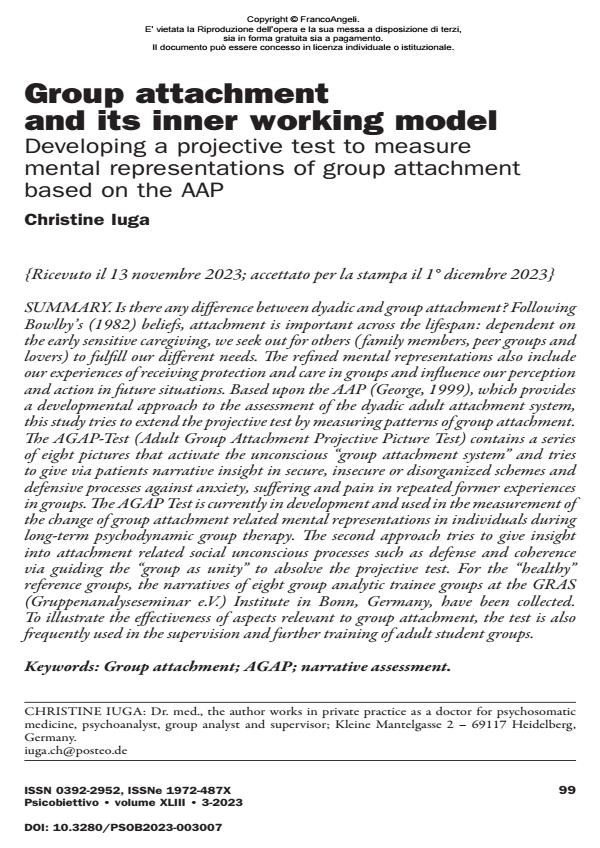Group attachment and its inner working model Developing a projective test to measure mental representations of group attachment based on the AAP
Journal title PSICOBIETTIVO
Author/s Christine Iuga
Publishing Year 2024 Issue 2023/3
Language English Pages 15 P. 99-113 File size 680 KB
DOI 10.3280/PSOB2023-003007
DOI is like a bar code for intellectual property: to have more infomation
click here
Below, you can see the article first page
If you want to buy this article in PDF format, you can do it, following the instructions to buy download credits

FrancoAngeli is member of Publishers International Linking Association, Inc (PILA), a not-for-profit association which run the CrossRef service enabling links to and from online scholarly content.
Is there any difference between dyadic and group attachment? Following Bowlby’s (1982) beliefs, attachment is important across the lifespan: dependent on the early sensitive caregiving, we seek out for others ( family members, peer groups and lovers) to fulfill our different needs. The refined mental representations also include our experiences of receiving protection and care in groups and influence our perception and action in future situations. Based upon the AAP (George, 1999), which provides a developmental approach to the assessment of the dyadic adult attachment system, this study tries to extend the projective test by measuring patterns of group attachment. The AGAP-Test (Adult Group Attachment Projective Picture Test) contains a series of eight pictures that activate the unconscious “group attachment system” and tries to give via patients narrative insight in secure, insecure or disorganized schemes and defensive processes against anxiety, suffering and pain in repeated former experiences in groups. The AGAP Test is currently in development and used in the measurement of the change of group attachment related mental representations in individuals during long-term psychodynamic group therapy. The second approach tries to give insight into attachment related social unconscious processes such as defense and coherence via guiding the “group as unity” to absolve the projective test. For the “healthy” reference groups, the narratives of eight group analytic trainee groups at the GRAS (Gruppenanalyseseminar e.V.) Institute in Bonn, Germany, have been collected. To illustrate the effectiveness of aspects relevant to group attachment, the test is also frequently used in the supervision and further training of adult student groups.
Keywords: Group attachment; AGAP; narrative assessment
Christine Iuga, Group attachment and its inner working model Developing a projective test to measure mental representations of group attachment based on the AAP in "PSICOBIETTIVO" 3/2023, pp 99-113, DOI: 10.3280/PSOB2023-003007